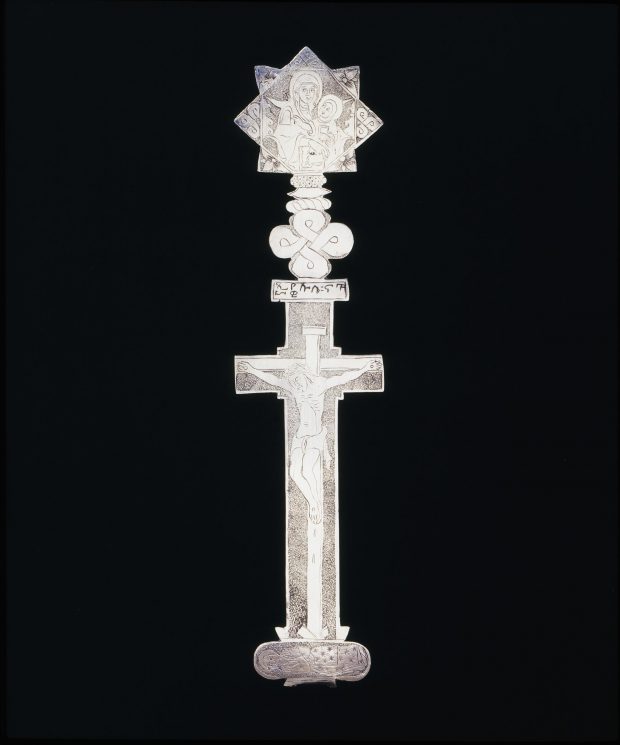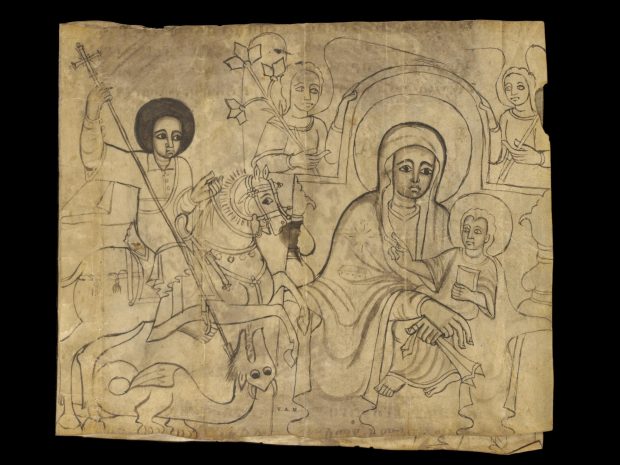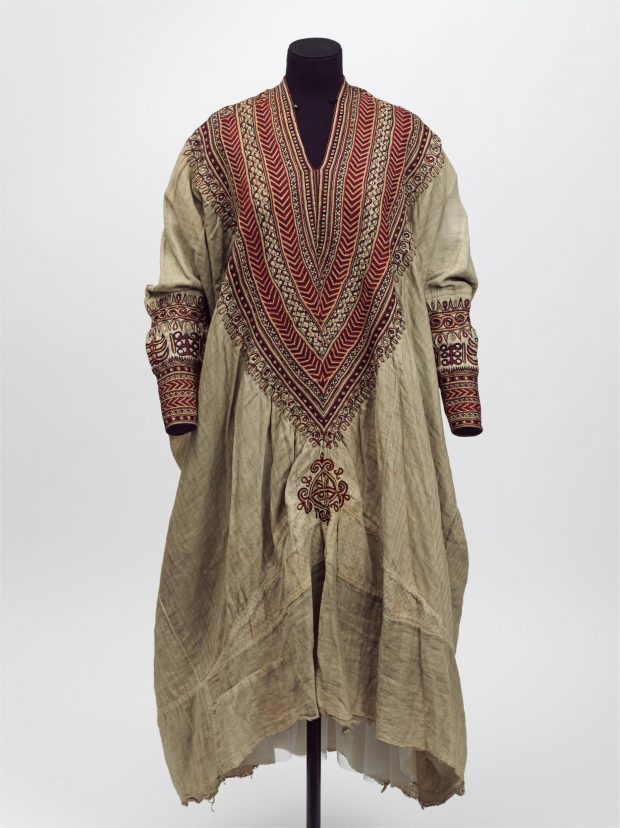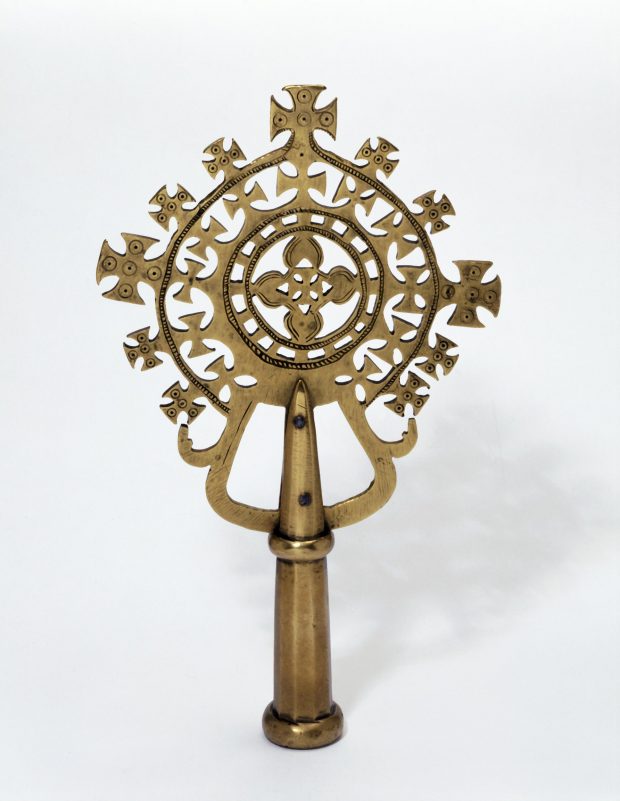On 20 April 1868, preparations for an unusual auction took place on the plain of Delanta in Ethiopia, a few miles north of the steep banks of the Bashilo river. As the sun passed its zenith, the area became strewn with hundreds of sacred and secular Ethiopian objects to be sold to raise prize-money for the British troops who had looted them a week before from the fortress of Maqdala.
Maqdala is one of those flat-topped mountains with near-vertical slopes that are dotted across Ethiopia and are known locally as amba. It is a natural fortress. Here Kassa, the son of a minor noble, established his base of operations long before becoming Emperor Tewodros II of Ethiopia through a network of political alliances and his military prowess. Here, in 1864, the Emperor imprisoned the British consul Charles Duncan Cameron together with the missionaries whose release the consul had been sent to obtain. Here he stored the treasures of a lifetime of campaigns, which he had at least partly acquired by pillaging the wealthy churches of Gondar in 1866. And finally, here he prepared his last stand against the British army in the spring of 1868. On April 13, unwilling to surrender in the face of defeat, Tewodros II took his life with a pistol that had been given to him by Queen Victoria.

Hand cross, (18th century), Ethiopia. Victoria and Albert Museum, London
Among the Ethiopian objects taken from the treasury of Tewodros II at Maqdala was a splendid 18th-century gold crown with embossed images of the Apostles and Evangelists. The crown may have been donated by an Ethiopian emperor to one of the churches of Gondar. The origins of this practice date back to Late Antiquity, when the Ethiopian King Kaleb sent his crown to Jerusalem to be hung upon the Holy Sepulchre. By donating precious objects and paraphernalia to churches, the Emperors of Ethiopia fulfilled an imperial duty, but they also ensured that the clergy would pray for their soul after they died.
After the auction at Delanta, the Maqdala crown was shipped off to England where it was deposited, in 1872, at the South Kensington Museum, now the V&A. Other objects found their way into different institutions. The largest number went to the British Museum, which acquired a collection of 350 manuscripts, now kept in the British Library, and a number of artefacts including eight processional crosses used in the liturgy.

St George and the Dragon, the Virgin and Child, (18th century), Ethiopia. Victoria and Albert Museum, London
The crown is currently on display at the V&A together with other Ethiopian artworks taken from Maqdala. This small exhibition, and the offer of the museum’s director to give some of the Maqdala objects on a long-term loan to Ethiopia, has reignited the debate about whether these items should be returned to their country of origin. The V&A’s collection also includes two exquisitely engraved hand crosses. Such crosses were used by the clergy as markers of identity and to bestow blessings on the faithful. The V&A’s website currently ascribes them to the 19th century, though, judging from their style, they probably belong to the first half of the 18th century. A bifolio with incomplete drawings, on the other hand, is currently dated to the 17th century, though it too belongs to the 18th century.

Woman’s dress (1860s), Ethiopia. Victoria and Albert Museum, London
In the heat of this discussion, the significance of the objects themselves has been largely overlooked, though an assessment of their value for the history of Ethiopian art should be an essential step in determining what their future should be. One point – an understandably controversial one – that needs to be made is that some of the secular objects that are kept at the V&A, such as the textiles and jewellery, are preserved in excellent conditions because they have been safeguarded in the museum. This is also true for the items preserved in other institutions such as the British Museum, which owns two beautiful royal tents made of silk damask.
Few such items are found in modern Ethiopia. Ethiopian church treasuries, which to this day function as the principal repositories of the country’s cultural heritage, have helped preserve Christian artworks. Secular items, on the other hand, were stored in the treasuries only if they were made of precious materials or had been owned by prominent members of the ruling class. Moreover, the storage conditions for textiles were, and often still are, less than ideal. Many sites and collections in Ethiopia are at risk of damage due to insufficient investment in conservation measures. This is a hard fact that cannot be ignored in decisions about what to return and how to do so.

Processional cross (before 1868), Ethiopia. Victoria and Albert Museum, London
Another point that should be made is that some pieces of the V&A’s collection are unique, while others are quite common. For example, in Ethiopia there are hundreds of processional crosses that are similar to the ones owned by the V&A. If returned, such items are unlikely to garner much interest. On the other hand, artworks such as the Maqdala crown and a gold eucharistic chalice would receive considerable attention in any of the country’s museums and could become assets for tourism. If to this one adds that they don’t present conservation challenges it becomes evident that the question of their return needs to be considered only from an ethical and legal standpoint.
Jacopo Gnisci is an art historian specialising in Ethiopian art and Christian manuscript illumination.

The looted Ethiopian artefacts that ended up in UK museums
Crown, probably made in Gondar, Ethiopia, around 1740. Victoria and Albert Museum, London
Share
On 20 April 1868, preparations for an unusual auction took place on the plain of Delanta in Ethiopia, a few miles north of the steep banks of the Bashilo river. As the sun passed its zenith, the area became strewn with hundreds of sacred and secular Ethiopian objects to be sold to raise prize-money for the British troops who had looted them a week before from the fortress of Maqdala.
Maqdala is one of those flat-topped mountains with near-vertical slopes that are dotted across Ethiopia and are known locally as amba. It is a natural fortress. Here Kassa, the son of a minor noble, established his base of operations long before becoming Emperor Tewodros II of Ethiopia through a network of political alliances and his military prowess. Here, in 1864, the Emperor imprisoned the British consul Charles Duncan Cameron together with the missionaries whose release the consul had been sent to obtain. Here he stored the treasures of a lifetime of campaigns, which he had at least partly acquired by pillaging the wealthy churches of Gondar in 1866. And finally, here he prepared his last stand against the British army in the spring of 1868. On April 13, unwilling to surrender in the face of defeat, Tewodros II took his life with a pistol that had been given to him by Queen Victoria.
Hand cross, (18th century), Ethiopia. Victoria and Albert Museum, London
Among the Ethiopian objects taken from the treasury of Tewodros II at Maqdala was a splendid 18th-century gold crown with embossed images of the Apostles and Evangelists. The crown may have been donated by an Ethiopian emperor to one of the churches of Gondar. The origins of this practice date back to Late Antiquity, when the Ethiopian King Kaleb sent his crown to Jerusalem to be hung upon the Holy Sepulchre. By donating precious objects and paraphernalia to churches, the Emperors of Ethiopia fulfilled an imperial duty, but they also ensured that the clergy would pray for their soul after they died.
After the auction at Delanta, the Maqdala crown was shipped off to England where it was deposited, in 1872, at the South Kensington Museum, now the V&A. Other objects found their way into different institutions. The largest number went to the British Museum, which acquired a collection of 350 manuscripts, now kept in the British Library, and a number of artefacts including eight processional crosses used in the liturgy.
St George and the Dragon, the Virgin and Child, (18th century), Ethiopia. Victoria and Albert Museum, London
The crown is currently on display at the V&A together with other Ethiopian artworks taken from Maqdala. This small exhibition, and the offer of the museum’s director to give some of the Maqdala objects on a long-term loan to Ethiopia, has reignited the debate about whether these items should be returned to their country of origin. The V&A’s collection also includes two exquisitely engraved hand crosses. Such crosses were used by the clergy as markers of identity and to bestow blessings on the faithful. The V&A’s website currently ascribes them to the 19th century, though, judging from their style, they probably belong to the first half of the 18th century. A bifolio with incomplete drawings, on the other hand, is currently dated to the 17th century, though it too belongs to the 18th century.
Woman’s dress (1860s), Ethiopia. Victoria and Albert Museum, London
In the heat of this discussion, the significance of the objects themselves has been largely overlooked, though an assessment of their value for the history of Ethiopian art should be an essential step in determining what their future should be. One point – an understandably controversial one – that needs to be made is that some of the secular objects that are kept at the V&A, such as the textiles and jewellery, are preserved in excellent conditions because they have been safeguarded in the museum. This is also true for the items preserved in other institutions such as the British Museum, which owns two beautiful royal tents made of silk damask.
Few such items are found in modern Ethiopia. Ethiopian church treasuries, which to this day function as the principal repositories of the country’s cultural heritage, have helped preserve Christian artworks. Secular items, on the other hand, were stored in the treasuries only if they were made of precious materials or had been owned by prominent members of the ruling class. Moreover, the storage conditions for textiles were, and often still are, less than ideal. Many sites and collections in Ethiopia are at risk of damage due to insufficient investment in conservation measures. This is a hard fact that cannot be ignored in decisions about what to return and how to do so.
Processional cross (before 1868), Ethiopia. Victoria and Albert Museum, London
Another point that should be made is that some pieces of the V&A’s collection are unique, while others are quite common. For example, in Ethiopia there are hundreds of processional crosses that are similar to the ones owned by the V&A. If returned, such items are unlikely to garner much interest. On the other hand, artworks such as the Maqdala crown and a gold eucharistic chalice would receive considerable attention in any of the country’s museums and could become assets for tourism. If to this one adds that they don’t present conservation challenges it becomes evident that the question of their return needs to be considered only from an ethical and legal standpoint.
Jacopo Gnisci is an art historian specialising in Ethiopian art and Christian manuscript illumination.
Share
Recommended for you
The kingdom built on frankincense and myrrh
A $20 billion project to transform Saudi Arabia’s al-Ula region has brought attention to a little-known ancient site
Could the antiquities trade do more to combat looting?
As the destruction of archaeological sites in Syria and Iraq continues, what can dealers of legal antiquities do to end the trade in illegally obtained artefacts, and the looting it encourages?
Ethiopian government seeks return of artefacts from V&A
Art news daily: 23 April